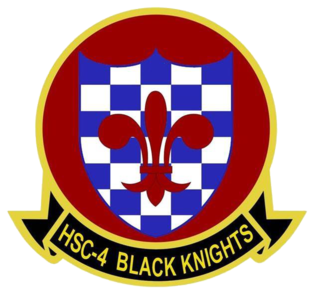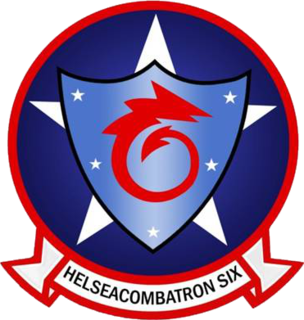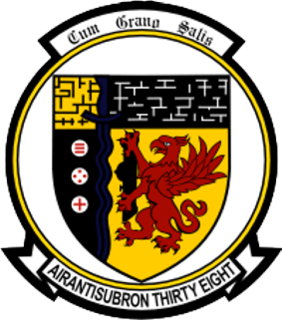
The Lockheed S-3 Viking is a four-crew, twin-engine turbofan-powered jet aircraft designed and produced by the American aerospace manufacturer Lockheed Corporation. Because of its characteristic sound, it was nicknamed the "War Hoover" after the vacuum cleaner brand.

VS-32, Sea Control Squadron 32, of the United States Navy, known as the Maulers was established as Composite Squadron 32 (VC-32) on 31 May 1949. It was redesignated Air Anti-Submarine Squadron 32 (VS-32) on 20 April 1950. The squadron initially flew the Grumman TBM-3E/-3W Avenger and was based at Naval Air Station Norfolk, Virginia. In 1951 the squadron moved to Naval Air Station Quonset Point, Rhode Island. VS-32 transitioned to the Grumman S2F-1 Tracker in 1954. The VS community moved in October 1973 to the homeport located at Naval Air Station Cecil Field, Florida. The squadron participated in Operation Desert Storm in 1991. Since the closing of NAS Cecil Field, the East coast VS Squadrons have moved to Naval Air Station Jacksonville in 1999. VS-32 was deactivated effective 30 September 2008 in a deactivation ceremony on 25 September.

A carrier air wing is an operational naval aviation organization composed of several aircraft squadrons and detachments of various types of fixed-wing and rotary-wing aircraft. Organized, equipped and trained to conduct modern US Navy carrier air operations while embarked aboard aircraft carriers, the various squadrons in an air wing have different but complementary missions, and provide most of the striking power and electronic warfare capabilities of a carrier battle group (CVBG). While the CVBG term is still used by other nations, the CVBG in US parlance is now known as a carrier strike group (CSG).

Carrier Air Wing Nine (CVW-9) is a United States Navy aircraft carrier air wing based at Naval Air Station Lemoore. The Air Wing is currently assigned to the aircraft carrier USS Abraham Lincoln (CVN-72). The Tail Code of aircraft assigned to CVW-9 is NG.

Carrier Air Wing Eight (CVW-8), is a United States Navy aircraft carrier air wing based at Naval Air Station Oceana, Virginia. The air wing is attached to the aircraft carrier USS Gerald R. Ford (CVN-78)

Carrier Air Wing Fourteen (CVW-14), was a United States Navy aircraft carrier air wing based at Naval Air Station Lemoore, California.

The Tactical Support Wing (TSW) is a United States Navy reserve air wing whose primary mission is operational and training support for active forces. Based at Naval Air Station Joint Reserve Base Fort Worth, the wing is composed of five squadrons and five Squadron Augment Units (SAU) in seven states.

Helicopter Sea Combat Squadron Four (HSC-4), also known as the Black Knights, is a multi-role combat helicopter squadron of the United States Navy based at Naval Air Station North Island which operates Sikorsky MH-60S Seahawk helicopters deployed aboard aircraft carriers. The squadron was originally established as HS-4 on 30 June 1952 at U.S. Naval Auxiliary Landing Field Imperial Beach with the Sikorsky HO3S-1 and was redesignated HSC-4 on March 29, 2012. It is currently assigned to Carrier Air Wing Two (CVW-2) which deploys aboard USS Carl Vinson (CVN-70).

Sea Control Squadron 22 (VS-22) Checkmates was a carrier-based United States Navy squadron based out of Naval Air Station Jacksonville in Florida. The squadron flew the Lockheed S-3B Viking and their mission was mining, undersea and surface warfare, electronic reconnaissance and analysis, over the horizon targeting, and aerial refueling. The squadron was last attached to Carrier Air Wing Seventeen (CVW-17) and was the last squadron flying the Viking. VS-22 was disestablished in a ceremony at NAS Jacksonville on January 29, 2009, and officially on March 31, 2009.

Helicopter Anti-Submarine Squadron 9 (HS-9) was the designation of two helicopter antisubmarine warfare squadrons of the United States Navy. The first squadron bearing the designation HS-9 was established on 1 June 1956 at Naval Air Station Quonset Point, Rhode Island with five HSS-1N “Seabat” helicopters. The squadron was disestablished on 1 October 1968. Eight years later, a new squadron was established on 4 June 1976; it was also designated HS-9. It deployed eight Sikorsky SH-3H “Sea Kings”. That squadron was disestablished on 30 April 1993.

Helicopter Sea Combat Squadron SIX (HSC-6), is a helicopter squadron of the United States Navy. It was established as Helicopter Antisubmarine Squadron SIX (HS-6) on 1 June 1956. Its nickname is Screamin’ Indians. On 8 July 2011 it was redesignated Helicopter Sea Combat Squadron SIX (HSC-6). It is based at Naval Air Station North Island, is part of Carrier Air Wing 17 and deploys aboard the aircraft carrier USS Nimitz (CVN-68).

Helicopter Sea Combat Squadron FIVE (HSC-5), also known as the Nightdippers, is a helicopter squadron of the United States Navy based at Naval Station Norfolk operating the Sikorsky MH-60S Seahawk. The Nightdippers are a part of Carrier Air Wing Seven and deploy aboard USS Harry S. Truman (CVN-75) to provide anti-surface warfare, search and rescue, vertical replenishment, Combat Search and Rescue and Naval Special Warfare Support capabilities to the carrier strike group.

Helicopter Sea Combat Squadron 11 (HSC-11), also known as the Dragonslayers, is a United States Navy helicopter squadron based at Naval Air Station Norfolk as part of Carrier Air Wing 1 operating MH-60S helicopters deployed aboard aircraft carriers. The squadron was established on 27 June 1957 at Naval Air Station Quonset Point as Helicopter Anti-Submarine Squadron 11 (HS-11) with Sikorsky HSS-1 Seabat helicopters. In 2016, HS-11 transitioned to MH-60S and re-designated as HSC-11.

Carrier Strike Group Seven was a U.S. Navy carrier strike group active from October 2004 until 30 December 2011. The strike group's antecendants included two previous aircraft carrier formations, Carrier Division Seven and Carrier Group Seven. Its heritage thus includes the Second World War, the Vietnam War, and the Cold War, as well as the first and the second Persian Gulf wars, encompassing a total of 34 deployments to the Western Pacific Ocean and Persian Gulf.

Sea Control Squadron 24 (VS-24) was a squadron of the United States Navy. Originally established as VB-17 on 1 January 1943, it was redesignated as VA-5B on 15 November 1946, redesignated as VA-64 on 27 July 1948, redesignated as VC-24 on 8 April 1949 and redesignated as VS-24 on 20 April 1950, it was disestablished on 1 June 1956. It was however reestablished again before being decommissioned in 2007.

Sea Control Squadron 37 or VS-37 also known as the "Sawbucks" was an Anti Submarine Warfare squadron that was decommissioned in 1995 along with CVW-15. During its active history, it flew during the Korean and Vietnam Wars as well as operating the last S-2 Trackers inservice with the US Navy in 1975.
In 1989, the United States Navy was on the verge of massive cuts to military spending cuts including ship and aircraft procurement. These forces were expected to fight the Soviet Union, Warsaw Pact and other potential adversaries in case of a war breaking out. At this time, the USS Kitty Hawk (CV-63) of the Pacific Fleet was out of commission for Service Life Extension Program (SLEP) modernization leaving the 3rd Fleet with less carriers.

Fleet Air Reconnaissance Squadron 6 (VQ-6) was a former squadron of the U.S. Navy's Atlantic Fleet. During its short-lived career, it was the second of two squadrons to operate the ES-3A Shadow, an ELINT version of the Lockheed S-3 Viking.

Sea Control Squadron 38 or VS-38, nicknamed the "Red Griffins" was a former United States Navy Anti-Submarine Warfare and later Sea-Control squadron between 1950 and 2004. During its service life, they took part in the Korean War, Vietnam War and the 1991 Gulf War and the 2003 Invasion of Iraq.

Sea Control Squadron 29 (VS-29) or the "Dragonfires" was a former Sea Control and anti-submarine warfare (ASW) squadron of the US Navy that existed between 1960 and 2004.



















